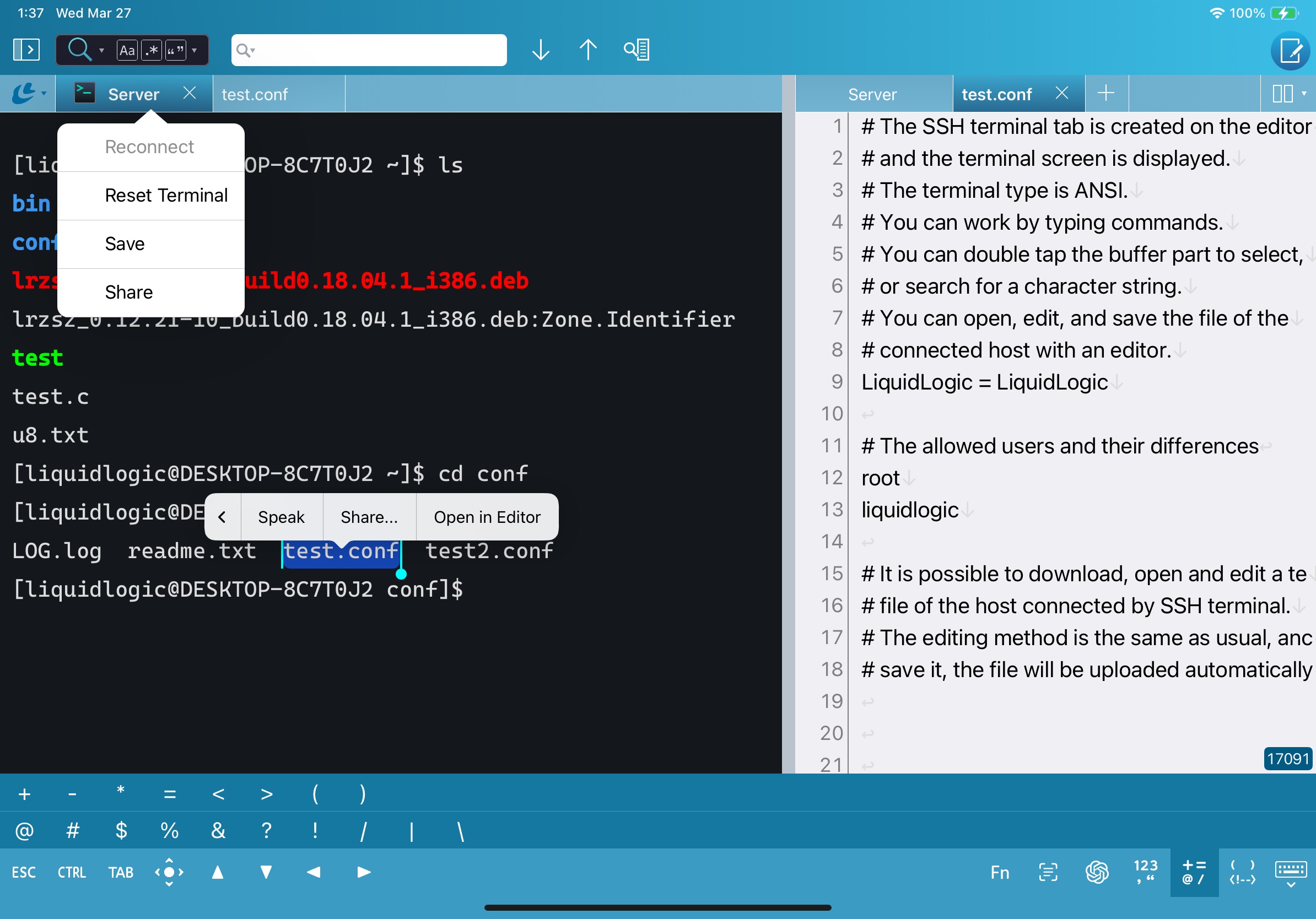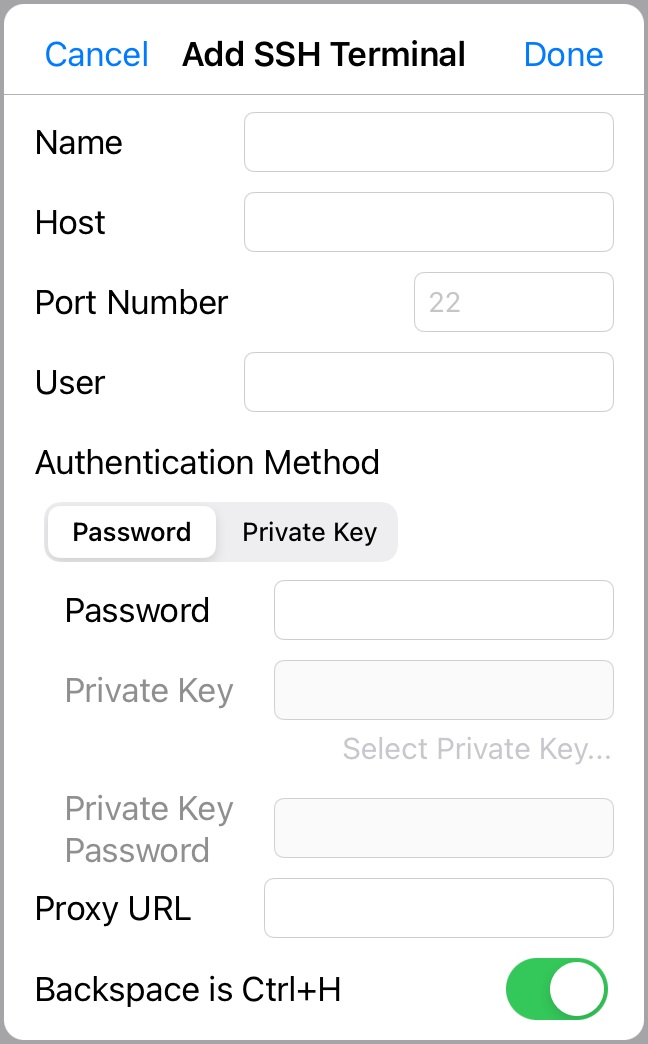MEGASOFT Top > Support > LiquidLogic > Manual > SSH Terminal

Client for LiquidLogic's SSH Terminal.
Set up an account and connect.
An SSH Terminal tab will be created on the editor screen and you will be at the terminal screen.
The terminal type is ANSI.
You can work by typing commands, and long-tap or double-tap to select a string for copying or pasting in the command section.
A feature unique to LiquidLogic is the ability to open, edit, and save host files in the editor.
▼SSH Terminal Screen
In the SSH terminal screen, select a file name and execute "Open in Editor" in the menu display.
The right side is the file editing screen that was actually opened (displayed in a left-right split state).

The SSH Terminal tab is prefixed with the "SSH Terminal" icon.
Close the SSH Terminal by tapping the "X" button on the tab.
A tap on the tab displays a menu related to the SSH terminal.
| Reconnect | Reconnect. |
|---|---|
| Reset Terminal | The terminal is reset and the screen display is refreshed. |
| Save | Saves what is displayed in the terminal as a text file. It cannot be stored on a host connected via SSH. |
| Share | Displays the share menu. |
This is for SSH terminal.
A function key input bar is added.
Other than that, it is the same as the normal editor screen.
When the device width is small, the up/down and left/right cursor keys are not displayed.

| Tap to input ESC key. | |
|
ON by tap: CTRL key is pressed. Automatically turns off when something is typed; also turns off with a tap. Locked by double-tap: Locked to the state where the CTRL key is pressed. Continues until it is turned off with a tap. |
|
| Tap to input TAB key. | |
|
Drag to move the cursor on the command line to the desired position. Drag up/down to go back/forward in command history. *Selection mode by double-tap is disabled in SSH Terminal. |
|
| Move cursor to up (go back through command history). | |
| Move cursor to down (forward command history). | |
| Move cursor to left. | |
| Move cursor to right. | |
| Display function key input bar. | |
| Dispaly numbers/punctuation input bar. | |
| Display symbols input bar. | |
| Display brackets/comments input bar. | |
| Turn off the keyboard. |
In the "App Settings", there are settings related to the SSH terminal.
You can set the color of the SSH terminal screen and the scroll buffer line.
You can add an account by tapping "Add Account" on the top screen of the filer and then tapping "SSH Terminal".
The added accounts can be edited, reordered, or deleted by tapping "Edit" in the upper right corner of the filer's top screen.
To edit, tap the account; to reorder, grab the three-line icon on the far right and drag; to delete, tap the red mark at the top.
▼Add/Edit SSH Terminal

| Name | Specify an appropriate account name (server name). |
|---|---|
| Host | Specify a host name or IP address. |
| Port Number | Specifies the port number. If no entry is made, the default of 22 is used. |
| *Please specify the following as necessary. | |
| User | Specify the user name to log in. |
| Authentication Method | Select the authentication method. GSS API certification is not supported. |
| Password | Specify a password. | Private Key | Execute "Select Private Key..." and select your private key file. ●Private Key The encryption methods supported are DSA, RSA, ECDSA, and Ed25519. Files can be in PuTTY ppk or pem format (no extension). |
| Private Key Password | Specify if a password for the private key is required. |
| Proxy URL | Specify if proxy settings are required. |
| Backspace is Ctrl+H | Back space specifies whether to Ctrl+H. |
LiquidLogic allows you to download a text file of the connected host via SSH terminal and open it in the editor window for editing.
The editing process is the same as usual; save the file and it will be uploaded automatically.
There are two ways to open a file: "Open in Editor" by selecting the file name or path name on the SSH terminal screen, or "Open by Command" by setting up a command on the server in advance and using it.
*The SSH terminal account at the time of opening must be connected when saving the file.
*Uploading of files with different file names is not allowed.
*Download/upload speed may be extremely slow in environments without the gzip command.
*This may not be available in cases such as when you are running a split display in a terminal.
●Open in Editor
This method is to open a file by selecting the file name or path name on the terminal screen and executing "Open in Editor" from the Edit menu.

*Available when the command is ready to be input.
*Long press on the terminal screen to select the file/path name.
*The location of the files is determined in the following order.
Absolute path → current directory → home directory
●Open by Command
This is a method of setting up a file for a command on the server and then opening the file by specifying the file in the command.
Example)$ liquidl test.txt

・File "liquidl" for the command
▶Download "liquidl"
・Preparation and Use
1.Download the file "liquidl" (no extension) from above and upload it to the server's home directory by SFTP or other means.
2.Log in via SSH and add execute permissions with the following command.
chmod 755 liquidl
3.Create a bin in your home directory and move to it.
mkdir ~/bin
mv liquidl ~/bin/
4.Add the home directory bin to the PATH environment variable.
If PATH is displayed and already exists, it is not necessary.
set | grep PATH
Add the following command.
PATH="$PATH:$(readlink -f ~/bin)"
5.Execute with liquidl followed by a file name or pathname.
Example)$ liquidl data/test.txt
*Options -s
Specify at runtime with sudo.
Note that the terminal will not be available while the file is open in the editor.
Example)$ sudo liquidl -s /root/file.txt